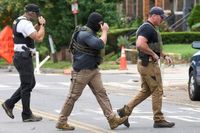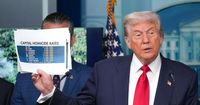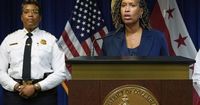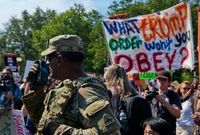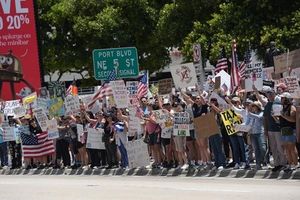On a sweltering August afternoon in 2025, the entrance to Washington, D.C.’s Union Station became a tableau of American tension and uncertainty. Protesters clustered at the edge of the plaza, their voices rising over the hum of city traffic. Police officers, visibly outnumbered, maintained a wary perimeter, while National Guard troops—brought in by President Donald Trump—stood sentinel at key intersections. The scene was set by a visit from Defense Secretary Pete Hegseth and Vice President JD Vance, but the true story was unfolding on the streets and in the halls of power, where the future of policing in the nation’s capital—and perhaps the country—was being fiercely debated.
President Trump’s decision to assume control of the Washington Metropolitan Police Department (MPD) and deploy the National Guard was, at least in part, a response to a real and pressing issue: a significant shortage of police officers. According to The Baltimore Sun, the MPD, authorized for 4,000 officers, was operating with just 3,200 as of August 2025—a 20% shortfall that has left the force at its smallest in half a century. This gap, critics and supporters alike agree, makes it difficult for the department to fulfill its mandate, even as crime rates in D.C. have begun to trend downward.
“It’s counterintuitive to believe that a police department operating without 20% of its assigned strength can meet 100% of its assigned responsibilities,” wrote Colin Pascal, a retired Army lieutenant colonel and graduate student at American University, in an opinion piece published on August 24, 2025. Pascal argued that augmenting local police with federal law enforcement is a logical short-term fix until the department can rebuild its ranks, but warned that such measures should have a clear endpoint. “Washington needs more police,” he stated, “but policing of city streets by the federal government is outside the American tradition.”
The MPD’s recruitment woes are hardly unique. Like many large urban forces, D.C.’s police have struggled to attract enough new officers to replace those leaving due to retirement or burnout. The situation is mirrored in Baltimore, where the police department is short nearly 500 officers out of an authorized force of more than 2,500. While local leaders celebrate the progress made in reducing crime, they acknowledge that without a fully staffed police force, further improvements will be hard to come by.
Yet, as Pascal and others have pointed out, the solution is not as simple as flooding the streets with federal agents or soldiers. “Each moment a federal agent spends riding a Metro train or walking a beat is a moment he or she isn’t performing other critical functions,” Pascal cautioned. The use of the National Guard, in particular, is fraught with risk. “If a video surfaces of a soldier hitting an American with a baton, firing rubber bullets into a crowd, or taking lethal action, the view of the military in the eyes of many Americans will change.”
President Trump, for his part, has framed the intervention as a necessary response to what he claims is an epidemic of crime and a cover-up by local authorities. At an August 11 news conference, he declared that Washington’s murder rate was higher than “we can find anywhere in the world”—a statement quickly disputed by multiple news outlets, which noted that at least six other U.S. cities had higher murder rates in 2023. Trump doubled down on social media, accusing D.C. officials of providing “Fake Crime numbers in order to create a false illusion of safety,” and announced that the Department of Justice was investigating alleged manipulation of crime data by the MPD.
The allegations are not entirely without precedent. In May 2025, police commander Michael Pulliam was placed on paid administrative leave after being accused of altering crime statistics in his district. The local police union has claimed that supervisors sometimes direct officers to downgrade felony reports to lesser offenses, and Trump-aligned legal groups have filed Freedom of Information Act requests and cited a settlement with a former sergeant who claimed offenses were misclassified. Still, experts say these incidents do not explain the overall decline in D.C. crime.
According to Cedric Alexander, a law enforcement veteran with over four decades of experience, the United States boasts two robust crime measurement systems: the National Crime Victimization Survey (NCVS) and the FBI’s Uniform Crime Reporting (UCR) Program. Both employ rigorous validation and quality assurance procedures. “Attempts to cast doubt on the reliability of the numbers don’t hold up,” the nonpartisan Brennan Center for Justice concluded. The FBI’s 2023 report incorporated data from more than 16,000 local agencies, covering 94% of the population, and the DOJ itself reported in January 2025 that “violent crime for 2024 in the District of Columbia is down 35% from 2023 and is the lowest it has been in over 30 years.” Homicides fell 32% in 2024 and another 12% in 2025, while carjackings dropped 37% in 2025, despite Trump’s claims that they had “tripled.”
Nevertheless, Trump’s rhetoric has found traction among some who are wary of D.C.’s local government. Congressional Democrats and civil rights leaders, however, have sounded the alarm, warning that the president’s actions represent “a soft launch of authoritarianism” and may be a “testing ground for what they might attempt in any other jurisdiction,” as reported by NPR. These concerns are amplified by the sense among local residents—especially young people and students—that the federal takeover has made them less safe, not more. “We’re afraid to go out because we’re afraid, one wrong step, one wrong move, off the crosswalk and I’m getting flagged down for something,” one college student told NPR.
Experts warn that undermining confidence in crime data and the agencies that produce them is a dangerous game. “When leaders make unfounded claims about data manipulation, the entire statistical infrastructure on which democracy depends is destroyed,” Alexander wrote. This erosion of trust, he and others argue, is part of a broader pattern in which political actors seek to weaken faith in key institutions—whether it’s the CDC, the media, or law enforcement itself. “Democracy can survive only on a solid foundation of the rule of law, which requires community trust and community buy-in,” Alexander emphasized.
Both sides of the political aisle have roles to play in addressing the underlying issues. Republicans, who currently control the federal government, could provide funding to help local jurisdictions raise police salaries and improve recruitment. Democrats, for their part, have largely moved away from anti-police rhetoric but must be careful not to undermine morale through hasty criticism or ambiguous statements about police conduct. As Pascal observed, “If we don’t celebrate the police even as we point out and work to correct their flaws, we discourage people from taking on the immense challenges of the job.”
Ultimately, the debate over policing in Washington, D.C., is about more than numbers or tactics—it’s about the delicate balance between security and civil liberties, between local control and federal oversight, and between truth and political expediency. As the city’s leaders, residents, and officers navigate this fraught moment, the choices they make could reverberate far beyond the capital’s boundaries.
In the end, the integrity of American democracy may hinge not just on who polices the streets, but on who counts the crimes—and who the public trusts to tell the truth about both.
